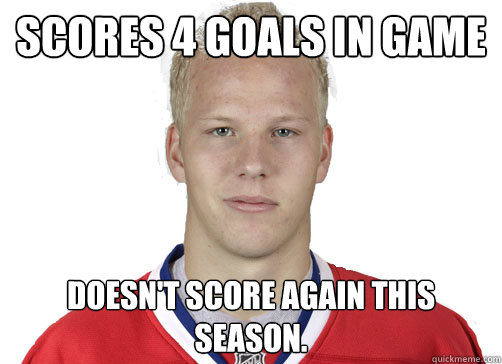Trotz's interview had me thinking about a personal experience. Last season, my wife and I attended the Washington Capitals Casino Night as an anniversary gift to each other. Sara was nearly 6 months pregnant at the time so we took it pretty easy, but it was a great time meeting the players, coaches, and other personalities and we will likely participate in it again one day if they ever bring it back. An unremarkable occurrence at the event, which led to a comment from Capitals forward Jay Beagle, has stuck with me ever since.
Having just passed by and said hello to then head coach Adam Oates, he kind of seemed to look right through me, as if I wasn't even there. Now, I was just one of a couple hundred fans on site, and he couldn't very well focus in on every single person, I get that. But one might imagine that he would show a much greater level of attention to his players, right? If you glean what I did from Beagle's comment, perhaps that wasn't the case.
Upon meeting Beagle, I told the hard-working grinder, and controversially occasional 1st liner, that I admired how hard he worked and that as a fan, it's inspiring to see a player approach the game with the zeal and blue-collar ethos that Beagle perpetuates. After he gave me a couple of rehearsed lines about how he "goes out there and leaves it all on the ice" he asked how I was enjoying the event. I told him it was awesome and that I'd just met Adam Oates and how big of a fan I was of him as a player (kindly omitting how I felt about him as a coach). "Oh yeah?", said Beagle. "And what'd he say?". Having had a few that night, I laughed and said, "You know, he kinda just looked right through me". Beagle lost it, punching me on the shoulder and doubling over, looking toward the Monumental Entertainment handler accompanying him who also laughed heartily. "You know what, he probably didn't even see you. You're probably right, he looked right through you."
When I saw Trotz's comments on Sportsnet yesterday, I couldn't help but think back to my brief discussion with Beagle. Sure, I'm just some nobody fan that Oates doesn't have much time for, but I can't help but think that judging by Beagle's reaction, Oates even treated his players that way. What sort of message would that send to a superstar athlete like Ovechkin? What sort of message would it send to the rest of the players? All in all, I'm just glad Oates is gone, co-coaching with Scott Stevens in New Jersey now, where his lack of coaching skill and perhaps even tact are only marginally destructive in an already fading organization on the eve of a rebuild.
A lot of discussion this season has centered around the culture in Washington, some of the new contracts they've brought in versus what has been expected of players. This has often been used as an excuse for why the advanced stats aren't always so great, why Brooks Orpik's impact is more than just how much he possesses the puck, why sometimes putting guys like Beagle on the top line with Ovechkin and Nick Backstrom is a necessary evil. A lot of the stats folks take great offense to this, they think it's all noise, and that there is nothing to the idea of culture that can't be somehow otherwise accounted for on the stats sheet. But to be sure, the voices in the locker room are much clearer now, much easier to digest and understand, and this is manifesting itself on the ice. The team seems much more cohesive, they are grasping a system that works and, for lack of a better term, buying-in to it. When they speak, Trotz hears them. When he looks into their eyes, he sees them, and best I can tell, he's that way with everyone outside of the organization, too.
Ultimately, the culture change isn't just impacting the organization and the team, it is impacting the fans as well. We are proud to be Capitals fans again, for the most part, and we ourselves are buying-in to Trotz and his system along with the players and the organization. As the team approaches the playoffs, it's easy to forget where this team was just one short year ago. Well out of a playoff position, a top prospect traded for a dud, a giant question mark in the net, Ovechkin the scorn of the hockey mainstream media. Yes, the future was bleak. So, the next time Jay Beagle mans the first line or Andre Burakovsky sees a scratch, perhaps we should find some perspective outside of our angst, no matter how justifiable it is.


















